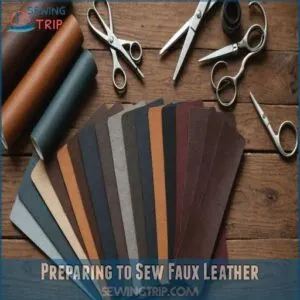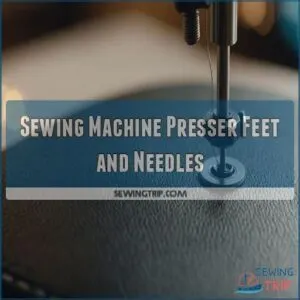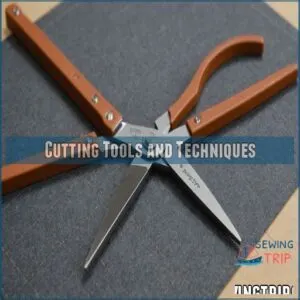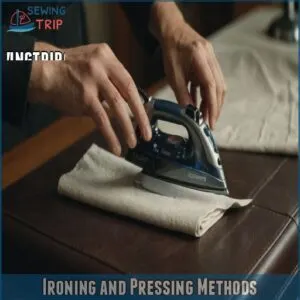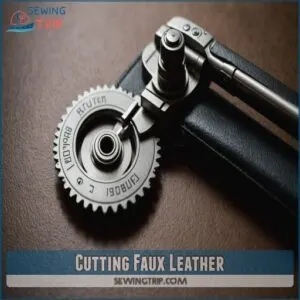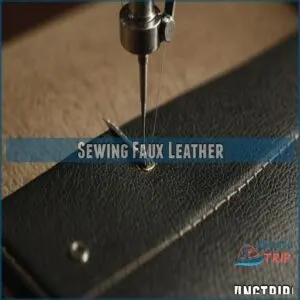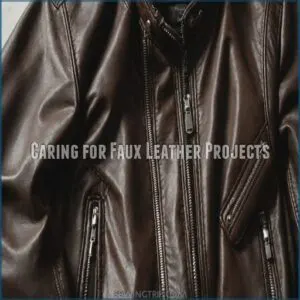This site is supported by our readers. We may earn a commission, at no cost to you, if you purchase through links.
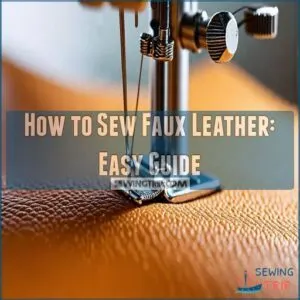
Grab some sharp microtex needles and set your stitch length to about 3.5 mm.
Avoid pins and use clips to keep everything in place—pins leave scars worse than a bad haircut.
Reduce the presser foot pressure to avoid pulling.
A walking foot can make life easier, but wax paper’s a handy trick too!
And when ironing seams, skip the iron; use a rubber mallet.
Curious about more faux leather secrets? Stick around for some game-changing tips.
Table Of Contents
Key Takeaways
- Use a rotary cutter instead of scissors to prevent unwanted holes in faux leather.
- Opt for leather or microtex needles with a stitch length of around 3.5 mm, and avoid using pins to prevent marks.
- Adjust presser foot pressure and try using a Teflon or walking foot for smooth sewing without sticking.
- When ironing seams, avoid using a standard iron and instead use a rubber mallet for best results.
Preparing to Sew Faux Leather
Before you start sewing faux leather, it’s essential to choose the right materials, and yes, that includes knowing your PU from your PVC.
Don’t worry, we’ll help you pick the best faux leather, sort out the right thread and needle, and keep things smooth and simple, avoiding sticky (or pokey) situations!
Choosing The Right Faux Leather
Choosing the right faux leather is like picking a favorite ice cream flavor—there’s a lot to love!
Consider the type: PU leather is flexible, while PVC is durable but less friendly to the environment.
Go wild with colors and patterns, from classic black to crocodile textures.
Just make sure it suits your project’s style and vibe.
Understanding Faux Leather Weight and Texture
You’ve got your faux leather picked out, now grasp its weight and texture.
Is it PVC or PU?
PU breathes like a dream, perfect for clothes.
Heavier faux leather works wonders in upholstery while lighter ones fit garments.
Feel the stretch, iron with care, and choose wisely.
That buttery feel you’re after? It’s all in understanding your fabric’s guts!
Selecting The Right Thread and Needle
Diving into faux leather sewing? Start by choosing a leather needle—size 16 or 18 works best.
Use strong polyester or nylon thread with an industrial thread weight for durable seams.
Match your thread type and needle size to the fabric thickness, ensuring smooth stitching.
Think of it as pairing the right shoes with your outfit—critical for success!
Essential Tools and Equipment
When you’re sewing faux leather, having the right tools can make all the difference, just like how using a spoon for soup saves the day at meal time.
You’ll need specialized presser feet, sharp cutting tools, and a few pressing tricks to help you stitch smoothly and avoid unwanted puckers.
Sewing Machine Presser Feet and Needles
Let’s talk sewing machine magic.
Ever tried stitching faux leather without a presser foot swap?
It’s like trying to ice skate on grass!
Stick with a Teflon or roller foot to avoid sticky situations.
And needles?
Go for leather or 90/14 denim types.
Adjust foot pressure just right—too much, and you’ve got an embossed effect nobody asked for!
Cutting Tools and Techniques
Someone told me cutting faux leather‘s a breeze.
You’ll need the right tools and to avoid common mistakes like not properly marking notches, which is essential for aligning seams and can be done by cutting a small triangle into the seam allowance, as explained in seam allowance tips.
Here’s what I recommend:
- Sharp fabric scissors for detail work.
- A
Ironing and Pressing Methods
Imagine this: you’re faced with a wrinkled sheet of faux leather.
Don’t fret! Use low heat settings and skip the steam; it’s the secret to wrinkle removal without turning your fabric into toast.
Pressing techniques involve gently smoothing out the wrinkles while using a pressing cloth for protection.
Remember, these methods are like your best recipe—gentle yet effective!
Cutting Faux Leather
When cutting faux leather, you’ll want to make clean and precise cuts to guarantee your project looks professional.
A sharp rotary cutter paired with careful measuring and marking will be your best friends, avoiding the dreaded dull-scissors disaster.
Techniques for Cutting Faux Leather
Cutting faux leather is a bit like working your way through a curvy road; you need good tools and patience.
Start with a steady hand and a sharp rotary cutter—trust me, it’s your best friend.
Pay attention to grain direction and pattern placement.
Use a seam roller and fabric alignment to keep everything smooth.
Pattern weights and wonder clips help avoid any slippage.
Using Rotary Cutters and Scissors
You’ve got your faux leather ready, now let’s cut it precisely using rotary cutters and scissors.
Make sure your rotary cutter’s blade is sharp—no one wants jagged edges.
For curves, these tools offer smooth control.
Choose scissors wisely; they should be sturdy, not flimsy.
Remember to factor in fabric thickness when cutting for a neat and clean result.
Keep sewing tools handy!
Marking and Measuring Faux Leather
When marking and measuring faux leather, accuracy is vital.
Don’t shy away from using marking tools that are easy to erase, ensuring your pattern placement lines up perfectly.
Consider the grain direction—it matters.
For precise cuts, utilize essential measuring tools for sewing.
Keep measuring tools handy and use pattern weights instead of pins.
A rotary cutter offers precision and control, giving your cuts that pro touch.
Setting Up Your Sewing Machine
Before you sew faux leather, it’s important to set up your sewing machine just right to avoid a sticky situation—literally!
Adjust the stitch length and presser foot pressure.
Use a walking foot or Teflon foot to guarantee a smooth, frustration-free sewing experience.
Choosing The Right Stitch Length
Before diving in, let’s talk stitch length. Getting this right is key for sewing with faux leather. Think of it as the foundation of your project’s strength and appearance.
When searching for the best stitch length, you can check out online resources like best stitch length faux leather.
Here’s what you need to know:
- Longer
Adjusting Presser Foot Pressure
Adjusting your presser foot pressure is like loosening your grip on a stubborn toy.
Too tight, and you’ll leave marks on your faux leather; too loose, and it’s slippin’ all over the place.
Find that Goldilocks zone where it’s just right.
It’s important for managing different faux leather types and ensuring the perfect foot pressure impact for your sewing project’s success.
Using a Walking Foot or Teflon Foot
Faux leather tends to stick faster than you can say, "Why’s it not gliding?"
That’s where a walking foot or Teflon foot comes in.
With a walking foot, layers move smoothly, reducing frustration and time wasted unsticking fabric.
Opt for a Teflon foot for a non-stick experience.
Both tools are like magic wands, offering sewing tips and foot alternatives.
Sewing Faux Leather
When sewing faux leather, you’ll want to use a longer stitch length and avoid backstitching to keep your seams intact.
Think of it as treating your faux leather like a friend with delicate sensibilities—gentle handling goes a long way!
Threading and Tensioning
Threading faux leather calls for the right mix—think needle choice and thread selection like polyester or nylon for quality stitching.
Too tight tension can lead to puckering like overcooked pasta; too loose, and your seams might unravel.
When sewing with faux leather, refer to specialized guides like sewing leather tips to learn techniques for working with thick fabrics. Use leather needles in your sewing machine, adjusting tension gently until it feels just right.
Voila—your top-stitching will shine!
Backstitching and Seam Finishes
Once you’ve tackled threading, let’s explore backstitching and seam finishes.
Faux leather doesn’t fray, so raw edge finishes are perfect.
Skip traditional backstitching—try tying off by hand.
Decorative stitches add flair, like a bow on a present.
Use your seam allowance wisely to stabilize the fabric.
Edge treatments enhance durability, giving your project a polished touch.
Tips for Preventing Puckering and Distortion
Feeling frustrated with puckering and distortion during sewing?
Adjust the tension and try using a walking foot or a Teflon foot, which can be found in a variety of teflon foot faux leather products.
This helps smooth fabric feeding.
Lighten the presser foot pressure to reduce marks on your faux leather.
Keep stitch length longer.
Caring for Faux Leather Projects
So, you’ve finished your awesome faux leather creation – congrats!
Now, let’s make sure it stays looking fabulous; proper care means your project will last, avoiding those preventable mishaps that can leave you sighing (I’ve been there!).
Cleaning and Conditioning Faux Leather
Everyone wants their faux leather to look snazzy and last long.
Here’s how to keep it in tip-top shape:
- Regular Dusting: Wipe with a soft cloth to banish dust.
- Stain Removal: Use gentle, faux leather-safe cleaners for pesky spots.
- Conditioning: Apply a DIY conditioner to keep it soft and flexible.
Protecting Faux Leather From Heat and Sunlight
Why risk it? Protecting your faux leather from heat and sunlight isn’t rocket science. Keep items in the shade, avoid direct UV rays, and use UV-resistant sprays for summer care. Remember, PU and PVC leather don’t love the sun. They can suffer from heat damage, leading to faded or cracked surfaces. Make faux leather care part of your routine!
| Faux Leather Care | UV Protection | Heat Damage |
|---|---|---|
| Use shade | UV spray | Avoid sun |
| Routine care | Spray effects | Cracking |
| Avoid heat | UV impact | Fading |
| Rotate items | Spray yearly | Warping |
| Inspect damage | Sun vs leather | Prevention |
Storing and Handling Faux Leather Projects
Imagine your faux leather project as a delicate treasure that craves gentle care, much like working with stable fabrics like cotton and linen that are forgiving for beginners.
Understanding fabric properties for beginners
To keep it pristine, store it flat to avoid creases and wrinkles.
Moisture can be a sneaky foe, so keep your masterpiece dry.
Hang it with care or lay it on a shelf, and you’ll guarantee its longevity.
Advanced Techniques and Embellishments
Ready to take your faux leather skills up a notch? Let’s explore piping, appliques, and adding a touch of bling with hardware for that extra wow factor!
Using Piping and Appliques
With faux leather, enhancing projects using piping and appliques is both simple and fun.
Choose sturdy piping materials that complement your design for a clean finish.
Secure your appliques carefully to prevent shifting—imagine them dancing out of place!
Explore various applique placements and make sure each stitch is tight and secure.
These sewing tips will transform your pleather creations into standout pieces.
Creating Faux Leather Embellishments
After mastering piping and appliques, why not explore faux leather embellishments?
For a unique touch, consider shopping for faux leather flowers online at faux leather flowers.
Craft faux leather flower patterns to add flair or design unique faux leather jewelry.
To add a professional touch, using a leather patch on hat guide can provide you with the necessary steps to create a high-quality finish. DIY leather patches can personalize your projects.
With clever faux leather applique techniques, your designs will shine.
Get creative with stitching.
Adding Hardware and Findings to Faux Leather Projects
Ready to add some pizzazz? Now that you’ve mastered embellishments, let’s talk hardware!
Find great hardware at craft stores or online.
Rivets, snaps, and zippers are popular choices.
Use heavy-duty needles and the right tools for a clean finish.
Remember safety first—always supervise kids near sharp tools.
Think stylish bags, belts, or even cool jackets!
You’ll be crafting like a pro in no time.
Frequently Asked Questions (FAQs)
How do you cut faux leather?
Cutting faux leather is like slicing butter—smooth but with a touch of resistance.
Use a sharp rotary cutter or scissors.
Keep your patterns stable with clips.
Take slow, deliberate cuts for the best results.
How to sew faux leather?
Sewing faux leather is like taming a wild beast gently.
Use a new leather needle, a walking foot, and longer stitches.
Avoid pinning—use clips instead.
They help you maneuver this tricky yet rewarding fabric.
Do you need a sewing machine to sew faux leather?
You’ll want a machine with a walking foot feature for a more even stitch, check out top leather sewing machines. You don’t absolutely need a sewing machine for faux leather, but it sure makes life easier.
Hand stitching works too, but requires patience and strong needles.
A machine speeds up the process and gives a cleaner finish.
Is faux leather a good fabric for sewing?
Stitching faux leather opens a world of creative possibilities.
It’s budget-friendly, vegan, and durable, perfect for those diving into bag-making or garments.
Embrace its easy maintenance and versatility; your crafting projects will thank you!
Can you sew leather?
It’s totally doable. Just grab a leather needle, a walking foot, and some strong thread. Sew slowly and steadily; you’ve got this! Remember to use clips, not pins.
How do you care for a faux leather sewing machine?
Like a vintage roadster, a good faux leather sewing machine needs a strong walking foot for thick leather, think of your faux leather sewing machine as a classic car.
Regularly clean it with a soft cloth.
Oil it per the manual.
Use a new leather needle for each project to keep it purring smoothly.
Can a regular sewing machine sew faux leather?
When working with leather, it’s essential to adjust your machine settings and use the right tools, such as leather needles and threads. You can definitely use a regular sewing machine for faux leather.
Just slip in heavy-duty needles and polyester thread.
Don’t forget that Teflon foot or matte tape trick to prevent sticking.
Happy sewing adventures await!
Is faux leather difficult to sew?
Sewing faux leather isn’t too tricky if you’re prepped right.
Use a leather needle and Teflon foot, and keep stitches long to avoid marks.
Handle with care, and it’d be like sewing’s second nature in no time!
What stitch to use on faux leather?
Picture yourself gliding a needle effortlessly through faux leather.
Go for a longer stitch like 5mm to avoid perforating the material.
It’s like a smooth dance, helping your seams strike the perfect balance of strength and flexibility.
Do I need a special needle to sew faux leather?
A leather needle is essential when adhering two pieces of faux leather together for a secure, strong stitch, just like when sewing real leather with the right leather sewing tools. A leather needle is like a trusty sidekick when sewing faux leather.
Its sharp, spearhead tip cleanly pierces the fabric, preventing skips and puckering.
Investing in one can make your sewing journey smoother and stress-free.
How to choose the best faux leather?
Imagine choosing faux leather like picking a movie—balance fun and practicality!
Opt for PU over PVC for breathability, check thickness for durability, and spice things up with unique textures or bold colors that match your style.
Can you paint or dye faux leather?
You can totally paint or dye faux leather!
Use specialized leather paints or dyes for best results.
It’s easier than you think; just prep your surface and let your creativity flow!
Is faux leather resistant to scratches?
Faux leather is pretty resistant to scratches, making it a popular choice for furniture and clothing.
But, keep in mind, sharp objects can still leave a mark.
Regular cleaning helps maintain its smooth, sleek look.
What are common uses for faux leather?
Ever wondered why faux leather is popping up everywhere?
It’s perfect for bags, wallets, and even stylish upholstery.
You get the look and feel of real leather without the guilt or high maintenance.
Ideal, right?
How does faux leather compare to real leather?
Real leather boasts a natural, rich texture and durability but requires upkeep and can be pricey.
Faux leather provides a cruelty-free, cost-effective alternative, offering water resistance and no fading risks—ideal for budget-friendly, vegan-friendly fashion enthusiasts!
Conclusion
Imagine you’re making a faux leather jacket for a friend, and it turns out perfect—no puckering or pinholes.
With the right tools and techniques, sewing faux leather becomes straightforward.
You’ve swapped pins for clips, discovered the magic of a rotary cutter, and mastered adjusting your presser foot.
Follow these tips, and sewing faux leather won’t just be doable—it’ll be easy.
So grab your supplies and start turning fabric into fabulous projects that’ll wow everyone!

